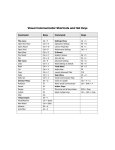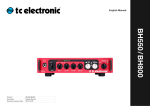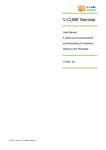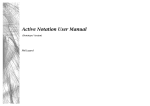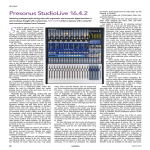Download USER'S MANUAL
Transcript
SPECIFICATION WIRELESS 9. System Specification USER’S MANUAL 9 ¾ Carrier Frequency Range : UHF band 630~928MHz ¾ RF Power Output : 10mW or 100Mw (max.) ¾ Frequency Stability : ±0.005% ¾ Maximum Deviation : ±48KHz with limiting compressor ¾ Spurious Emission : >60dB below carrier frequency ¾ T.H.D. : <1% (at 1KHz) ¾ Power supply : DC12 ~ 18V ¾ Tone key (mono) : 32.768 KHz ¾ Current consumption : 170mA ±10Ma (10mW) ; 250mA ±10Ma (100mW) ¾ Dimension(mm) WxHxD : 211 x 44 x 180 DESIGN AND SPECIFICATIONS SUBJECT TO CHANGE WITHOUT NOTICE. 440-0168-5 NOTE WIRELESS 6.3.3 Broadcasting System The stationary transmitter also can be used as broadcasting system in factory construction, stadium, school… Or combine with the antenna booster to extend the reception range. WIRELESS MICROPHONE SYSTEM Table of Contents Page 1. Introduction …………………………………………………………….….….…….……….…… 1 2. Safety ………………………………………………………………………………….………….……… 1 3. Environment ………………………………………………………………………………………... 1 4. Wireless Note….………………………………………….………………………………..……... 1 5. Product Description …………….…………………..……………………..…….………..… 2 5.1 Stationary Transmitter 6.3.4 Multiple Systems 6. Some performers need to hear their own voice or sound while on performance, you need to hear yourself to be your best. By using multiple monitoring systems, each performer hears a combination of sound and their own voice. Each system includes everything a working performer needs to receive consistent personal monitor mixes. Setting Up ………………………………………………….…………………………………...…… 5 6.1 Connecting the transmitter to power 6.2 Setting up the frequency 6.3 Setting up the transmitter 7. Troubleshooting ………………………….……………………………..………….…………… 8 7 8. System Feature……………………………………………………………….…………………... 8 9. System Specification…………………………………………………………………..………. 9 WIRELESS WIRELESS NOTE NOTE WIRELESS FCC Statement 6.3.1 Mixing System This device complies with part 15 of the FCC rules. Operation is subject to the following two conditions: (1)This device may not cause harmful interference and (2) This device must accept any interference received, including interference that may cause undesired operation This is the basic wireless configuration for user, either instrument or vocal. By switching to Stereo mode, user can set up the background music on one channel and vocal on the other. Or switching to the Mono mode, user can have background music and vocal combination for both earphones. Notice : The changes or modifications not expressly approved by the party responsible for compliance could void the user’s authority to operate the equipment. IMPORTANT NOTE: To comply with the FCC RF exposure compliance requirements, no change to the antenna or the device is permitted. Any change to the antenna or the device could result in the device exceeding the RF exposure requirements and void user’s authority to operate the device. 1. Introduction Thank you for purchasing our product. This in-ear monitor system operates in UHF band frequency with Phase Locked Loop (PLL) synthesizer controlled. The system with 16 or 64 selectable frequencies via Phase Locked Loop (PLL) circuitry makes it easy to choose non-interfered channels. Please read this instruction manual carefully before operating the system. This manual covers the function and operation of the in-ear monitor system. 2. Safety ¾ Do not spill liquid on the appliance and do not drop it on a hard concrete floor. ¾ Do not place the appliance near heat sources such as radiators, amplifier, or etc. Do not expose it to direct sunlight, extremely dust, excessive moisture, or vibration. ¾ Unplug the power if the appliance has been not used for a long period. This will avoid the damage resulted by surge electricity. 3. Environment 6.3.2 Recording System The stationary transmitter also can be used as recording system in concert, rehearsing, personal performance or instant translating. ¾ When disposing the equipment, remove the batteries, separate the case, circuit boards, and cables, and dispose of all components in accordance with local waste disposal rules. 4. Wireless Note ¾ Before setting up, make sure that the transmitter and receiver are tuned to the same frequency. Do not use two or above transmitters operating in the same frequency. ¾ Use good quality batteries to avoid the damage resulting from a defective leaking battery. ¾ Turn the volume control on the receiver to adjust receiver output level to match input level requirements of an audio mixer or amplifier. ¾ To avoid interference, do not put the receiver too near metal object and avoid obstructions between transmitter and receiver. ¾ Avoid the interference from TV, radio, other wireless appliances and etc. 1 6 WIRELESS SETTING UP PRODUCT DESCRIPTION WIRELESS 6. Setting Up 5. Product Description NOTICE: 5.1 Stationary Transmitter The stationary transmitter operates in UHF band frequency with PLL synthesized control. UHF 16 or 64 preprogrammed selectable frequencies to avoid interference. (The number of frequency channels depends on local regulations.) Prior to setting up, please make sure the microphone and the receiver are turned to the same frequency. Two or more wireless transmitters operating in the same frequency can not be used at the same time and area. So please select the different frequencies which can be used simultaneously at the same area 6.1 Connecting the transmitter to power ¾ Attach the UHF antenna to the TNC connector on the rear panel. 5.1.1 16 Channel Selectable Type ¾ Please check the voltage of the supplied AC adapter conforms to the voltage available in local area. Using the wrong AC adapter may cause irreparable damage to the unit. ¾ Plug the feeder cable of the supplied AC adapter into DC IN socket on the transmitter. Then plug the AC adapter into a power outlet. 10 6.2 Setting up the frequency ¾ For 16 channels model, adjust channel rotary to select channel to set up frequency. L ¾ For 64 channels model, frequency is divided into 8 groups, which there are 8 channels in each group. Adjust group rotary to setup group number. Adjust channel rotary to setup channel number. VOLUME R PHONES PEAK MONO POWER STEREO 6.3 Setting up the transmitter ¾ Connect the audio equipment output to R (right) / L (left) Line input connectors on the back panel of the transmitter by using 6.3Φ plug or XLR plug cable. MIN MAX MIN MAX MIN MAX CH ¾ Set the Mono/Stereo Switch in front panel of transmitter to “Stereo” or “Mono” position according to user’s demand. 1 2 4 5 6 7 8 9 ¾ If the input signal is too strong, please set the input level switch to “-30dB” position; contrarily please set the input level switch to “0dB” position. ¾ In Stereo Mode, the signal on left channel goes to the left earphone, and the signal on right channel goes to the right earphone. ¾ In Mono Mode, the signal on the left and right earphone is mixed sound. 5.1.2 64 Channel Selectable Type ¾ Turn the R (right) / L (left) Volume Control on the front panel of transmitter clockwise to set the transmitter input to receiver level. 10 ¾ For monitoring purpose, plug the headphone into the monitoring headphone jack on the front panel of transmitter. Use the Monitoring Headphone Volume on the front panel of transmitter to adjust the headphone volume. ¾ Never use the balanced and unbalanced audio outputs at the same time! This may cause signal loss or increased noise. L POWER STEREO GR 1 5 VOLUME R PHONES PEAK MONO 2 3 MIN MAX MIN MAX MIN MAX CH 4 5 6 7 8 9 2 WIRELESS 5.1.3 PRODUCT DESCRIPTION PRODUCT DESCRIPTION Rear Panel R 0dB WIRELESS To combine two transmitters in a 19” standard rack by using 2 short L type plastics racks (L2) and 2 metal connecting plates (C1). (Each system includes a L2 and a C1.) -30dB 0dB L DC 12V 500mA -30dB RF OUT L2 R LINE IN L LINE OUT C1 11 1. 2. 3. 4. 5. 6. 7. 8. 9. 10. 11. 12. 13. 14. 15. 12 13 12 14 15 Power: Push bottom to power on and push again to power off. Channels LED Display: Indicate the current channel number. The number would show up when the power is on. Group Rotary: Adjust rotary to select frequency group. Channel Rotary: Adjust rotary to select frequency channel. Mono/Stereo Switch: Switch the stereo or mono mode of audio signal. Left Volume Control: Adjust the volume of Left LINE IN level. Right Volume Control: Adjust the volume of Right LINE IN level. Monitoring Headphone Volume Control: Adjust the volume of headphone. Headphone Jack: 6.3Φ headphone jack stereo type. Peak Indicator: Indicate if the input audio signal is too high and may cause distortion. Antenna Socket: TNC socket for antenna. Input Level Switch: Adjust the input level for 0dB or -30dB operation. Input Connectors: Electronically balanced inputs that accommodate XLR or 6.3Φ plug at 0dB or -30dB level. Output Connectors: For connecting with another transmitter or audio equipment. DC Power Jack: DC input connector for the supplied AC adapter. To mount a transmitter in a 19” standard rack by using 2 L type long metal racks (L1). (L1 is an optional product, so please purchase extra in local shops.) L1 Antenna holder makes it easy to fix wherever for connection antenna. can be assembled on the mic stand or on the wall. Antenna holder TNC female connector for connecting with UHF antenna TNC female connector for connecting with cable or antenna booster (long distance required) Screw adapter to screw AH-1 on a microphone stand. 3 4 WIRELESS 5.1.3 PRODUCT DESCRIPTION PRODUCT DESCRIPTION Rear Panel R 0dB WIRELESS To combine two transmitters in a 19” standard rack by using 2 short L type plastics racks (L2) and 2 metal connecting plates (C1). (Each system includes a L2 and a C1.) -30dB 0dB L DC 12V 500mA -30dB L2 RF OUT R LINE IN L LINE OUT C1 11 1. 2. 3. 4. 5. 6. 7. 8. 9. 10. 11. 12. 13. 14. 15. 12 13 12 14 15 Power: Push bottom to power on and push again to power off. Channels LED Display: Indicate the current channel number. The number would show up when the power is on. Group Rotary: Adjust rotary to select frequency group. Channel Rotary: Adjust rotary to select frequency channel. Mono/Stereo Switch: Switch the stereo or mono mode of audio signal. Left Volume Control: Adjust the volume of Left LINE IN level. Right Volume Control: Adjust the volume of Right LINE IN level. Monitoring Headphone Volume Control: Adjust the volume of headphone. Headphone Jack: 6.3Φ headphone jack stereo type. Peak Indicator: Indicate if the input audio signal is too high and may cause distortion. Antenna Socket: TNC socket for antenna. Input Level Switch: Adjust the input level for 0dB or -30dB operation. Input Connectors: Electronically balanced inputs that accommodate XLR or 6.3Φ plug at 0dB or -30dB level. Output Connectors: For connecting with another transmitter or audio equipment. DC Power Jack: DC input connector for the supplied AC adapter. To mount a transmitter in a 19” standard rack by using 2 L type long metal racks (L1). (L1 is an optional product, so please purchase extra in local shops.) L1 Antenna holder makes it easy to fix wherever for connection antenna. can be assembled on the mic stand or on the wall. Antenna holder TNC female connector for connecting with UHF antenna TNC female connector for connecting with cable or antenna booster (long distance required) Screw adapter to screw AH-1 on a microphone stand. 3 4 WIRELESS SETTING UP 6. Setting Up NOTICE: Prior to setting up, please make sure the microphone and the receiver are turned to the same frequency. Two or more wireless transmitters operating in the same frequency can not be used at the same time and area. So please select the different frequencies which can be used simultaneously at the same area 6.1 Connecting the transmitter to power ¾ Attach the UHF antenna to the TNC connector on the rear panel. PRODUCT DESCRIPTION WIRELESS 5. Product Description 5.1 Stationary Transmitter The stationary transmitter operates in UHF band frequency with PLL synthesized control. UHF 16 or 64 preprogrammed selectable frequencies to avoid interference. (The number of frequency channels depends on local regulations.) 5.1.1 16 Channel Selectable Type ¾ Please check the voltage of the supplied AC adapter conforms to the voltage available in local area. Using the wrong AC adapter may cause irreparable damage to the unit. ¾ Plug the feeder cable of the supplied AC adapter into DC IN socket on the transmitter. Then plug the AC adapter into a power outlet. 10 6.2 Setting up the frequency ¾ For 16 channels model, adjust channel rotary to select channel to set up frequency. L ¾ For 64 channels model, frequency is divided into 8 groups, which there are 8 channels in each group. Adjust group rotary to setup group number. Adjust channel rotary to setup channel number. POWER VOLUME R PHONES PEAK MONO STEREO MIN MAX MIN MAX MIN MAX CH 6.3 Setting up the transmitter ¾ Connect the audio equipment output to R (right) / L (left) Line input connectors on the back panel of the transmitter by using 6.3Φ plug or XLR plug cable. ¾ Set the Mono/Stereo Switch in front panel of transmitter to “Stereo” or “Mono” position according to user’s demand. 1 2 4 5 6 7 8 9 ¾ If the input signal is too strong, please set the input level switch to “-30dB” position; contrarily please set the input level switch to “0dB” position. ¾ In Stereo Mode, the signal on left channel goes to the left earphone, and the signal on right channel goes to the right earphone. ¾ In Mono Mode, the signal on the left and right earphone is mixed sound. 5.1.2 64 Channel Selectable Type ¾ Turn the R (right) / L (left) Volume Control on the front panel of transmitter clockwise to set the transmitter input to receiver level. 10 ¾ For monitoring purpose, plug the headphone into the monitoring headphone jack on the front panel of transmitter. Use the Monitoring Headphone Volume on the front panel of transmitter to adjust the headphone volume. ¾ Never use the balanced and unbalanced audio outputs at the same time! This may cause signal loss or increased noise. L POWER STEREO GR 1 5 VOLUME R PHONES PEAK MONO 2 3 MIN MAX MIN MAX MIN MAX CH 4 5 6 7 8 9 2 WIRELESS WIRELESS NOTE NOTE WIRELESS FCC Statement 6.3.1 Mixing System This device complies with part 15 of the FCC rules. Operation is subject to the following two conditions: (1)This device may not cause harmful interference and (2) This device must accept any interference received, including interference that may cause undesired operation This is the basic wireless configuration for user, either instrument or vocal. By switching to Stereo mode, user can set up the background music on one channel and vocal on the other. Or switching to the Mono mode, user can have background music and vocal combination for both earphones. Notice : The changes or modifications not expressly approved by the party responsible for compliance could void the user’s authority to operate the equipment. IMPORTANT NOTE: To comply with the FCC RF exposure compliance requirements, no change to the antenna or the device is permitted. Any change to the antenna or the device could result in the device exceeding the RF exposure requirements and void user’s authority to operate the device. 1. Introduction Thank you for purchasing our product. This in-ear monitor system operates in UHF band frequency with Phase Locked Loop (PLL) synthesizer controlled. The system with 16 or 64 selectable frequencies via Phase Locked Loop (PLL) circuitry makes it easy to choose non-interfered channels. Please read this instruction manual carefully before operating the system. This manual covers the function and operation of the in-ear monitor system. 2. Safety ¾ Do not spill liquid on the appliance and do not drop it on a hard concrete floor. ¾ Do not place the appliance near heat sources such as radiators, amplifier, or etc. Do not expose it to direct sunlight, extremely dust, excessive moisture, or vibration. ¾ Unplug the power if the appliance has been not used for a long period. This will avoid the damage resulted by surge electricity. 3. Environment 6.3.2 Recording System The stationary transmitter also can be used as recording system in concert, rehearsing, personal performance or instant translating. ¾ When disposing the equipment, remove the batteries, separate the case, circuit boards, and cables, and dispose of all components in accordance with local waste disposal rules. 4. Wireless Note ¾ Before setting up, make sure that the transmitter and receiver are tuned to the same frequency. Do not use two or above transmitters operating in the same frequency. ¾ Use good quality batteries to avoid the damage resulting from a defective leaking battery. ¾ Turn the volume control on the receiver to adjust receiver output level to match input level requirements of an audio mixer or amplifier. ¾ To avoid interference, do not put the receiver too near metal object and avoid obstructions between transmitter and receiver. ¾ Avoid the interference from TV, radio, other wireless appliances and etc. 1 6 NOTE WIRELESS 6.3.3 Broadcasting System The stationary transmitter also can be used as broadcasting system in factory construction, stadium, school… Or combine with the antenna booster to extend the reception range. WIRELESS MICROPHONE SYSTEM Table of Contents Page 1. Introduction …………………………………………………………….….….…….……….…… 1 2. Safety ………………………………………………………………………………….………….……… 1 3. Environment ………………………………………………………………………………………... 1 4. Wireless Note….………………………………………….………………………………..……... 1 5. Product Description …………….…………………..……………………..…….………..… 2 5.1 Stationary Transmitter 6.3.4 Multiple Systems 6. Some performers need to hear their own voice or sound while on performance, you need to hear yourself to be your best. By using multiple monitoring systems, each performer hears a combination of sound and their own voice. Each system includes everything a working performer needs to receive consistent personal monitor mixes. Setting Up ………………………………………………….…………………………………...…… 5 6.1 Connecting the transmitter to power 6.2 Setting up the frequency 6.3 Setting up the transmitter 7. Troubleshooting ………………………….……………………………..………….…………… 8 7 8. System Feature……………………………………………………………….…………………... 8 9. System Specification…………………………………………………………………..………. 9 TROUBLESHOOTING WIRELESS 7. Troubleshooting Problem Solution No sound ¾ Check the power supply of the transmitter and receiver. ¾ Check if the earphone is plugged into the mini receiver. ¾ Check that the transmitter and receiver are tuned to the same frequency. ¾ Check whether the hi-fi appliance is switched on and the receiver output is connected to audio mixer or amplifier input. ¾ Check by headphone monitor on the front of transmitter to check the sound. ¾ Check whether receiver is located too near metal object or there are obstructions between transmitter and receiver. Sound interference ¾ Check the antenna location. ¾ When using 2 or above microphone sets simultaneously, make sure that the chosen frequencies are not interfered. ¾ Check the transmitter input level switch is set on the proper position. 0dB or -30dB. ¾ Check whether the interference comes from other wireless microphones, TV, radio and etc. Distortion ¾ Make sure no other transmitter is operating on same frequency. ¾ Check whether the interference comes from other wireless microphones, TV, radio and etc. 8. System Feature ¾ Stationary transmitter is a Low-Power FM broadcasting transmitter. At the same time, it can send out stereo music (work with CD player, MP3, etc.) and vocal broadcasting (works with wired or wireless microphone system). ¾ There are up to 16 or 64 selectable channels to set up a multi-channels broadcasting system and to avoid the frequency interference. Also, the LED displayer gives us a clear channel indication. And, user can select channels or groups easily by using rotary switch. ¾ The stereo audio signal (works with CD player, MP3, audio mixer, etc.) can be input easily through the XLR or 6.3Φ plug. ¾ The wired microphone can be connected with the 6.3Φ jack or the XLR connector. ¾ The Peak LED indicator can help avoiding the audio distortion. ¾ User can plug a headphone into the headphone jack on the front panel to monitor the sending out audio signal. ¾ The stationary transmitter’s antenna is a high efficiency antenna. The service area can be improved when the antenna is placed at higher and clear place. ¾ The unidirectional antenna is recommended to use for ensuring the reception quality. ¾ The stationary transmitter can combine with a RF power booster which is 1Watt max to used for an over 1 km area service. 8 SPECIFICATION WIRELESS 9. System Specification USER’S MANUAL 9 ¾ Carrier Frequency Range : UHF band 630~928MHz ¾ RF Power Output : 10mW or 100Mw (max.) ¾ Frequency Stability : ±0.005% ¾ Maximum Deviation : ±48KHz with limiting compressor ¾ Spurious Emission : >60dB below carrier frequency ¾ T.H.D. : <1% (at 1KHz) ¾ Power supply : DC12 ~ 18V ¾ Tone key (mono) : 32.768 KHz ¾ Current consumption : 170mA ±10Ma (10mW) ; 250mA ±10Ma (100mW) ¾ Dimension(mm) WxHxD : 211 x 44 x 180 DESIGN AND SPECIFICATIONS SUBJECT TO CHANGE WITHOUT NOTICE. 440-0168-5













